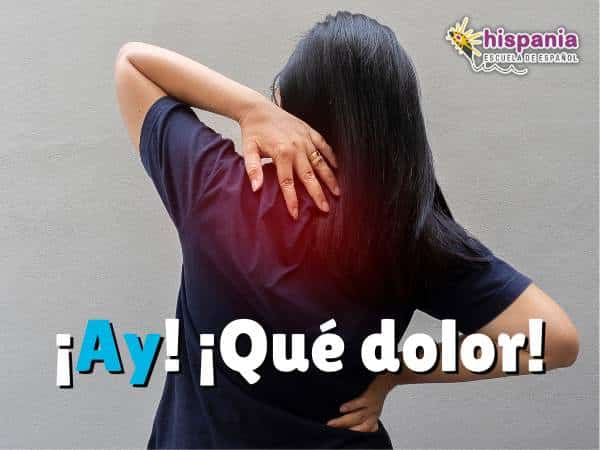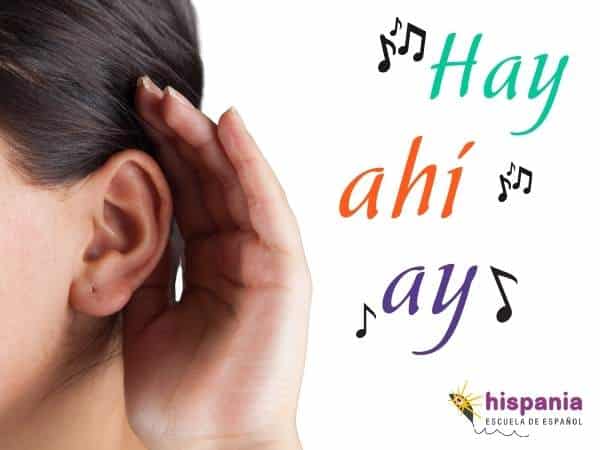
Oh, there is and there. Do you know how to differentiate them?
Good Morning!
We hope you have rested well and have a fresh mind because today we are going to talk to you about something very interesting: words there, you'll find y Oh.
These movies are three words they sound very similar but they have totally different meanings, that is why they cause a lot of confusion in studies.ianyou have spanish
Today you will finally learn how to use each one correctly.
In addition to knowing the difference between oh, there y you'll find Would you like to give your Spanish level a boost?
With us, this will be a piece of cake. In Hispania, escuela de español we offer Spanish courses of all levels.
If you live abroad and do not have the possibility of coming to Valencia, we also have online Spanish courses so you can learn Spanish remotely.
We know you are wanting to know the difference between oh, there is y there, so we are not going to lengthen it any further. Let's go to see her!
HAY: verb haber
¿What does it mean you'll find ?
There is is impersonal form of the verb haber.
And what is impersonal? Well, he doesn't have a person. That is, it does not have a subject that performs the action of "haber".
And, then, what if there is no subject? When can this form be used? you'll find vocabulary?
There are only two cases.
Read on to find out!

Existence
You’ll experience an explosion of colour and interactive activities whilst the verb you'll find of having to express existence of things, people, animals, etc., that are in a place.
For example:
- in my refrigerator you'll find 4 tomatoes.
- In this street you'll find many stores.
- In the square you'll find benches to sit on.
- There is a little dog waiting for his owner at the door of the supermarket.
As you see, no one does the action you'll find . It has no subject.
It doesn't matter if what is there is singular or plural, it is always written the same way.
Periphrasis of obligation
There is is a verb which is also used to express obligation in the periphrasis must + infinitive.
It is also impersonal. It's used in general obligations that several people should do, not just someone in particular.
- you have to clean thoroughly this kitchen.
- Bring Roberto to the hospital.
You’ll also They can be obligations that apply to everyone.
- To learn a language well, you have to practice it a lot and study grammar.
- To be healthy, must eat well and do sports.

OW: interjection
Ay is a interjection.
That is, a sound that people make to manifest emotions concrete.
¿What does it mean ay?
Ay It is usually used in an exclamatory way to appeal to emotions of surprise, complaint and pain.
Let's see examples of this interjection ay with exclamation in their different emotions☝🏻.
Surprise
Imagine that a friend gives you surprising news. For example, that she is getting married.
You could say:
- Yeah! Do not tell me? !! Congratulations!!
Complaint
You’ll also we can express complaint or regret for something negative.
For example, we walk down the street and accidentally bump into a person. So we can tell you:
- Yeah! I'm sorry!
You will surely use it a lot because it is very common to complain about the temperature. In fact, don't be surprised to go out into the street and hear the Spanish say:
- Yeah! what a heat
- Yeah! How cold!
Pain
When something hurts us, it is also common to use this interjection to express our suffering.
- Yeah! My head hurts.

THERE: Adverb of place
There really has a intonation different from you'll find y ay, since it has two syllables and the syllable that is pronounced most strongly is the last.
Which is the meaning of there?
There is a adverb of place and indicates the place where something is or an action is performed.
For example:
- The Spanish book is there.
- There, in that cafeteria, is where we met.
- My class friend is always there, in the same seat.
There It's not the only one adverb of place. They are also here y over there.
How are they different?ian?
On the distance.
Here presents something that is search of the subject.
- The mobile is here, in my table. I can touch it.
There refers to something that is a little more far.
- My wallet is there, in that drawer.
Alli talks about something that is pretty far, beyond our range.
- AlliBehind that building, Josefina works.
Now you know the difference between there, there and oh. Bravo!👏🏻
As you can see, they are words that are easy to confuse due to their pronunciation and minor spelling changes that have.
This is something that happens frequently in the Spanish language. Let's talk a little about it and see other similar words.

The confusion of sound
The three words se pronounceian in a very similar way. Especially you'll find o ay, which is exactly the same, since the h in Spanish it is silent.
We call this phenomenon homophony, and it occurs in many words in Spanish.
Homophones words
Homophones are words that share the same soundwhich are changeian in its meaningsuch as, you'll find y Oh.
As you see, it was pronouncedian same, but they are written differently.
In this case we see the difference in the h.
There are many other homophonous words in Spanish. Let's look at some examples:
- Echo / done
Echo is the participle of verb to throw. Done is the participle of verb to do.
- go/fence
Go is the present subjunctive of verb to go. open It is an advertising poster that is placed in the streets.
In our article on go, fence and berry We explain this very well 😉.
- Beautiful/hairy
Beautiful It means that something has beauty, that it is pretty. Hair refers to the soft body hair that we all have.
- Vast / Coarse
extensive It is something very big and broad. Like a mountain landscape with cliffs. enough, on the other hand, speaks of a person who does not have elegance or good manners.
These are just some examples of words that are pronounceian same but what changedian of meaning. There are many more!
THERE IS – THERE: The power of pronunciation
What's up with you'll find y there? Are they also homophones?
Well... not really, since the sound of both is not exactly the same. The pronunciation changes due to the accent.
En you'll find , the strength is in the only vowel, the a.
However, in the word there, the stressed vowel is í.
In fact, the accent marks it for us.
And why does it have an accent? Because it is an acute word ending in a vowel.
If you want to know more about the accentuation rules in Spanish, take a look at our article 😉.
activity to practice
It's time to practice these three words with an exercise.
You have to write you'll find , ay o there in each sentence according to the context.
Luck!
Easy right?
Now you have acquired this knowledge and you can return to it whenever you want. If you are interested in learning Spanish, we recommend that you read more articles on our blog.
But, above all, we advise you to come to Hispania, escuela de español and to learn Spanish with the best equipment.
In just a few months, your language level will skyrocket.
Do you have any questions about this topic or about our school?
If so, take advantage of the comments box and ask us 🤗.
¡Nos vemos!
Article written by Carlos Martínez for Hispania, escuela de español.
More articles



